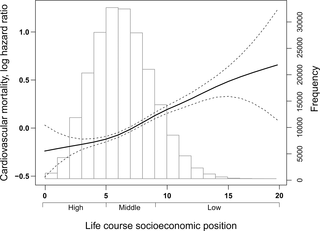PLOS Medicine ( IF 15.8 ) Pub Date : 2018-01-02 , DOI: 10.1371/journal.pmed.1002476 Eirik Degerud 1 , Inger Ariansen 1 , Eivind Ystrom 1, 2, 3 , Sidsel Graff-Iversen 1 , Gudrun Høiseth 1, 4 , Jørg Mørland 1, 5 , George Davey Smith 6 , Øyvind Næss 1, 7

|
Background
Socioeconomically disadvantaged groups tend to experience more harm from the same level of exposure to alcohol as advantaged groups. Alcohol has multiple biological effects on the cardiovascular system, both potentially harmful and protective. We investigated whether the diverging relationships between alcohol drinking patterns and cardiovascular disease (CVD) mortality differed by life course socioeconomic position (SEP).
Methods and findings
From 3 cohorts (the Counties Studies, the Cohort of Norway, and the Age 40 Program, 1987–2003) containing data from population-based cardiovascular health surveys in Norway, we included participants with self-reported information on alcohol consumption frequency (n = 207,394) and binge drinking episodes (≥5 units per occasion, n = 32,616). We also used data from national registries obtained by linkage. Hazard ratio (HR) with 95% confidence intervals (CIs) for CVD mortality was estimated using Cox models, including alcohol, life course SEP, age, gender, smoking, physical activity, body mass index (BMI), systolic blood pressure, heart rate, triglycerides, diabetes, history of CVD, and family history of coronary heart disease (CHD). Analyses were performed in the overall sample and stratified by high, middle, and low strata of life course SEP. A total of 8,435 CVD deaths occurred during the mean 17 years of follow-up. Compared to infrequent consumption (<once/month), moderately frequent consumption (2–3 times per week) was associated with a lower risk of CVD mortality (HR = 0.78, 95% CI 0.72, 0.84) overall. HRs for the high, middle, and low strata of SEP were 0.66 (95% CI 0.58, 0.76), 0.87 (95% CI 0.78, 0.97), and 0.79 (95% CI 0.64, 0.98), respectively, compared with infrequent users in each stratum. HRs for effect modification were 1.30 (95% CI 1.10, 1.54, p = 0.002; middle versus high), 1.23 (95% CI 0.96, 1.58, p = 0.10; low versus high), and 0.96 (95% CI 0.76, 1.21, p = 0.73; low versus middle). In the group with data on binge drinking, 2,284 deaths (15 years) from CVDs occurred. In comparison to consumers who did not binge during the past year, HRs among frequent bingers (≥1 time per week) were 1.58 (95% CI 1.31, 1.91) overall, and 1.22 (95% CI 0.84, 1.76), 1.71 (95% CI 1.31, 2.23), and 1.85 (95% CI 1.16, 2.94) in the strata, respectively. HRs for effect modification were 1.36 (95% CI 0.87, 2.13, p = 0.18; middle versus high), 1.63 (95% CI 0.92, 2.91, p = 0.10; low versus high), and 1.32 (95% CI 0.79, 2.20, p = 0.29; low versus middle). A limitation of this study was the use of a single measurement to reflect lifetime alcohol consumption.
Conclusions
Moderately frequent consumers had a lower risk of CVD mortality compared with infrequent consumers, and we observed that this association was more pronounced among participants with higher SEP throughout their life course. Frequent binge drinking was associated with a higher risk of CVD mortality, but it was more uncertain whether the risk differed by life course SEP. It is unclear if these findings reflect differential confounding of alcohol consumption with health-protective or damaging exposures, or differing effects of alcohol on health across socioeconomic groups.
中文翻译:

生命历程的社会经济地位、中年饮酒模式和心血管死亡率:挪威人口健康调查分析
背景
与弱势群体相比,社会经济弱势群体在接触相同水平的酒精时往往会遭受更多伤害。酒精对心血管系统有多种生物效应,既有潜在危害,也有保护作用。我们调查了饮酒模式与心血管疾病 (CVD) 死亡率之间的不同关系是否因生命周期社会经济地位 (SEP) 的不同而不同。
方法和结果
从包含挪威基于人口的心血管健康调查数据的 3 个队列(郡研究、挪威队列和 40 岁计划,1987-2003)中,我们纳入了自我报告饮酒频率信息的参与者(n = 207,394)和暴饮暴食(每次≥5单位,n = 32,616)。我们还使用了通过链接获得的国家登记处的数据。使用 Cox 模型估计 CVD 死亡率的风险比 (HR) 和 95% 置信区间 (CI),包括酒精、生命历程 SEP、年龄、性别、吸烟、体力活动、体重指数 (BMI)、收缩压、心脏率、甘油三酯、糖尿病、CVD 病史和冠心病 (CHD) 家族史。对整个样本进行分析,并按生命历程 SEP 的高、中、低层进行分层。在平均 17 年的随访期间,共有 8,435 例 CVD 死亡。与不频繁食用(<一次/月)相比,适度频繁食用(每周 2-3 次)总体上与较低的 CVD 死亡风险相关(HR = 0.78,95% CI 0.72,0.84)。与不常使用者相比,SEP 高、中、低层的 HR 分别为 0.66 (95% CI 0.58, 0.76)、0.87 (95% CI 0.78, 0.97) 和 0.79 (95% CI 0.64, 0.98)在每个阶层。效果修改的 HR 分别为 1.30(95% CI 1.10、1.54,p = 0.002;中与高)、1.23(95% CI 0.96、1.58,p = 0.10;低与高)和 0.96(95% CI 0.76、1.21) ,p = 0.73;低与中)。在酗酒数据组中,有 2,284 人(15 岁)死于 CVD。与过去一年没有暴饮暴食的消费者相比,经常暴饮暴食(每周≥1次)的HR总体为1.58(95%CI 1.31,1.91),1.22(95%CI 0.84,1.76),1.71(95)地层中的 % CI 分别为 1.31, 2.23) 和 1.85 (95% CI 1.16, 2.94)。效果修正的 HR 分别为 1.36(95% CI 0.87, 2.13,p = 0.18;中与高)、1.63(95% CI 0.92, 2.91,p = 0.10;低与高)和 1.32(95% CI 0.79, 2.20) ,p = 0.29;低与中)。这项研究的局限性是使用单一测量来反映一生的饮酒量。
结论
与不频繁消费相比,适度频繁消费的 CVD 死亡风险较低,而且我们观察到,这种关联在整个生命过程中 SEP 较高的参与者中更为明显。经常酗酒与较高的 CVD 死亡风险相关,但更不确定该风险是否因生命历程 SEP 的不同而不同。目前尚不清楚这些发现是否反映了饮酒与健康保护或损害性接触的不同混杂,或者酒精对不同社会经济群体健康的不同影响。



























 京公网安备 11010802027423号
京公网安备 11010802027423号